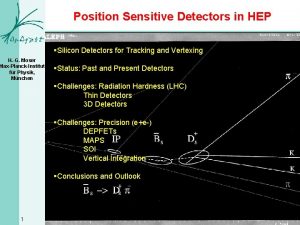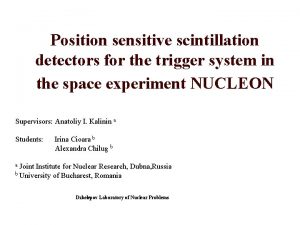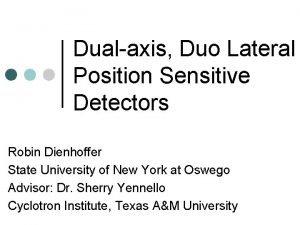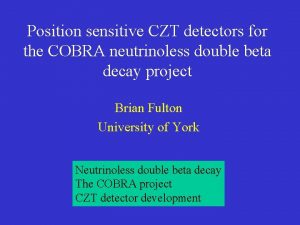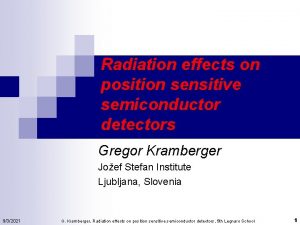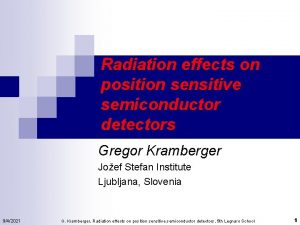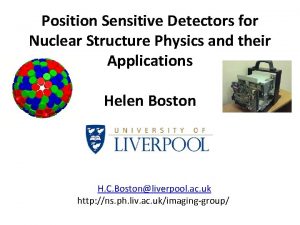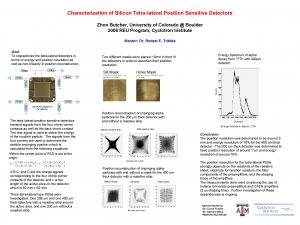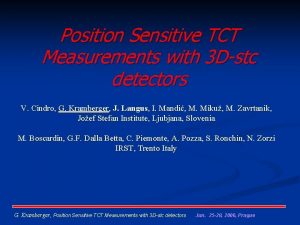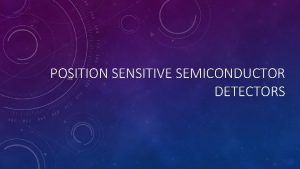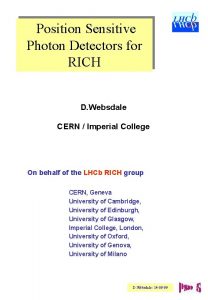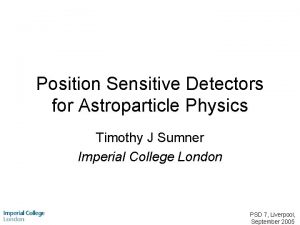7 th International Conference on Position Sensitive Detectors














- Slides: 14

7 th International Conference on Position Sensitive Detectors – PSD 7 Liverpool (UK), 12 -16 September 2005 R&D on MAPS for High Energy Physics P. P. Allportb, R. Batesc, G. Casseb*, J. Crooksa, A. Evansb, L. Jonesa, V. O’Sheac, R. Turchettaa*, M. Tyndela, J. J. Velthuisb, G. Villania, F. Zakopoulosa a Rutherford Appleton Laboratory, United Kingdom b University of Liverpool, United Kingdom c University of Glasgow, United Kingdom Presented by Renato Turchetta CCLRC - RAL

PSD 7, Liverpool, 2005 Outline Introduction. Monolithic Active Pixel Sensors (MAPS) aka CMOS sensors for imaging. Requirements Results Noise Radiation hardness CMOS sensors with in-pixel storage: Flexible APS (FAPS) Conclusions 2

PSD 7, Liverpool, 2005 CMOS Image Sensors aka Monolithic Active Pixel Sensor (MAPS) CMOS sensors for imaging, introduced in early ’ 90 s. At the beginning, CMOS sensors used for low-end applications Constant improvement in the technology: noise, QE, … CMOS sensors widely used in high-end consumer and prosumer cameras For high-speed imaging (industrial, HDTV, …) CMOS sensors have already the best performance in terms of noise. All major players in imaging field are improving the technology. IEEE Workshop on CCD and Advanced Image Sensors IEEE Workshop on Image Sensors 3

4 PSD 7, Liverpool, 2005 CMOS Monolithic Active Pixel Sensor Ø all-in-one detector-connectionreadout = Monolithic Camera-ona-chip Readout control Ø Standard CMOS technology Ø small size / greater integration Ø low power consumption Ø radiation resistance Ø system-level cost Ø increased speed (column- or pixel - parallel processing) Ø random access (Region-of-Interest ROI readout) Column-parallel ADCs Data processing / Output stage What is needed for Particle Physics ? Camera control Ø Increased functionality

5 PSD 7, Liverpool, 2005 MAPS for particle detection Metal layers Requirements 1) Efficiency: 100% or close 2) Noise: signal ~ 100 s e-/h pairs 3) Radiation hardness: Mrad and beyond 4) Speed: ‘frame rate’ > 106/sec Polysilicon N+ N+ P-Well Potential barriers Pepitaxial layer 5) Large area: side ~ cm’s P-substrate Radiation Dielectric for insulation and passivation -+ N+ -+ N-Well P-Well -+ - + High energy - + particles generate about -+ 80 e-/h pair per -+ mm - + - + P+

PSD 7, Liverpool, 2005 6 RAL Sensors for Particle Physics UK collaboration to develop MAPS for Particle Physics and Space Science (also Leicester/Brunel, Birmingham) Parametric test sensor: RAL_HEPAPS family RAL_HEPAPS 1: 0. 25 mm, 2 mm (!) epitaxial layer, 64*8 pixels, 15 mm pitch: 3 MOS, 4 MOS RAL_HEPAPS 2: 0. 25 mm CIS, 8 mm epitaxial layer, 384*224 pixels, 15 mm pitch: 3 MOS, 4 MOS, Charge. Pre. Amplifier (CPA), Flexible APS (FAPS, 20 mm pitch) RAL_HEPAPS 3: 0. 25 mm MM, no epitaxial layer, 192*192 pixels, 15 mm pitch: 3 MOS, 4 MOS, Deep N-well diodes Test sensors RAL_HEPAPS 4: 0. 35 mm CIS, 20 mm epitaxial layer, 1026*384 pixels, 15 mm pitch. 3 versions: 1, 2 or 4 diodes per pixel. Rad-hard, 5 MHz row rate (manufactured, preparing tests)

7 PSD 7, Liverpool, 2005 Soft and hard reset Vreset RESET Measured noise distributions for a Diode ROW_SELECT 64 x 64 pixel test structure. Not corrected for system noise Output Hard reset RESET – Vreset > Vth for reset transistor Noise (ENC in e- rms) Soft reset RESET ~ Vreset. A factor of >~2 reduction (reset in the dark) Noise (ENC in e- rms)

8 PSD 7, Liverpool, 2005 Radiation hardness Transistors. Threshold shift: reduces with shrinking feature size 0. 25 micron Bird’s beak effect: use enclosed geometry transistors Transistor leakage current: use guard-rings to separate transistors Diodes. Radiation damage increases leakage current Radiation damage reduces minority carrier lifetime diffusion distance is reduced ~tox 2

PSD 7, Liverpool, 2005 9 Single pixel S/N dependence on impact point Device simulation. Single diode 15 mm pixel Device simulation. 4 -diode 15 mm pixel No rad 1014 1015 • Less variation in S/N varies over pixel before and after irradiation. G. Villani (RAL) • S at edges still usable after 1015 p/cm 2.

10 PSD 7, Liverpool, 2005 Landau Distributions Beta source (Ru 106) test results. Sensors HEPAPS 2. Examples of clusters. S/N per pixel Landau distributions Summary table Type Specs S N S/N 3 MOS E 4 diodes 99 4. 94 20. 1 3 MOS C GAA 87 4. 85 18. 0 3 MOS B Diode 1. 2 x 1. 2 92 3. 87 23. 8 3 MOS A Diode 3 x 3 67 3. 31 20. 3 4 MOS C Lower VT 101 4. 14 24. 4 4 MOS B Higher VT 114 4. 70 24. 2 4 MOS A Reference 111 4. 45 25. 0

11 PSD 7, Liverpool, 2005 S/N Noise (ADU counts) Radiation test. Summary Dose (log 10(p/cm 2)) Signal (ADU counts) Dose (log 10(p/cm 2)) • Sensors yield reasonable S/N up to 1014 p/cm 2 • 0. 35 mm technology in the pixel transistors. Enclosed layout in 3 MOS_E • S/N reduction seems to be dominated by charge collection Dose (log 10(p/cm 2)) J. Velthuis (Liv)

12 PSD 7, Liverpool, 2005 Flexible Active Pixel Sensor Pulses LED test (single pixel) Amplitude Light pulse 10 memory cell per pixel 28 transistors per pixel 20 mm pitch 40 x 40 arrays Design for the Vertex detector at the International Linear Collider Time

13 PSD 7, Liverpool, 2005 FAPS. Landau distribution • Test with source • Correlated Double Sampling readout (subtract Scell 1) • Correct remaining common mode and pedestal • Calculate random noise Seed 3 x 3 5 x 5 – Sigma of pedestal and common mode corrected output • Cluster definition – Signal >8 seed – Signal >2 next • Note hit in cell i also present in cell i+1. • S/Ncell between 14. 7± 0. 4 and 17. 0± 0. 3 J. Velthuis (Liv)

PSD 7, Liverpool, 2005 14 Conclusions Parametric test sensors used to study noise, radiation hardness, new designs. Radiation hardness 1014 p/cm 2 Noise < 20 e- rms (soft reset in dark) Three versions for radiation hardness of fast (5 MHz/line), rad-hard, large (1024*384) sensor (RAL_HEPAPS 4) manufactured FAPS architecture developed for vertex detector at ILC Digital pixel architecture (R&D within MI 3 collaboration, N. Allinson et al. ) in development for CALICE Electromagnetic Calorimeter at ILC (P. Dauncey, Imperial College et al. ). Would require large area coverage 104 m 2, stitched sensors CMOS technology could provide the solution for coverage of large areas with pixel detectors
 First position second position third position
First position second position third position Where are feature detectors located
Where are feature detectors located Kinesthesis and vestibular sense
Kinesthesis and vestibular sense Feature vectors
Feature vectors Feature detectors
Feature detectors Frontier detectors for frontier physics
Frontier detectors for frontier physics Yodsawalai chodpathumwan
Yodsawalai chodpathumwan Photo detectors
Photo detectors Streaming current detectors
Streaming current detectors Vhv voltage detectors
Vhv voltage detectors Photo detectors
Photo detectors Nuclear detectors
Nuclear detectors Adsorption chromatography
Adsorption chromatography Giant wave detectors murmurs universe
Giant wave detectors murmurs universe Wave could hear murmurs across universe
Wave could hear murmurs across universe















